Sir John Monash, Personal Files Book 12, 3 April - 30 April 1916, Part 3
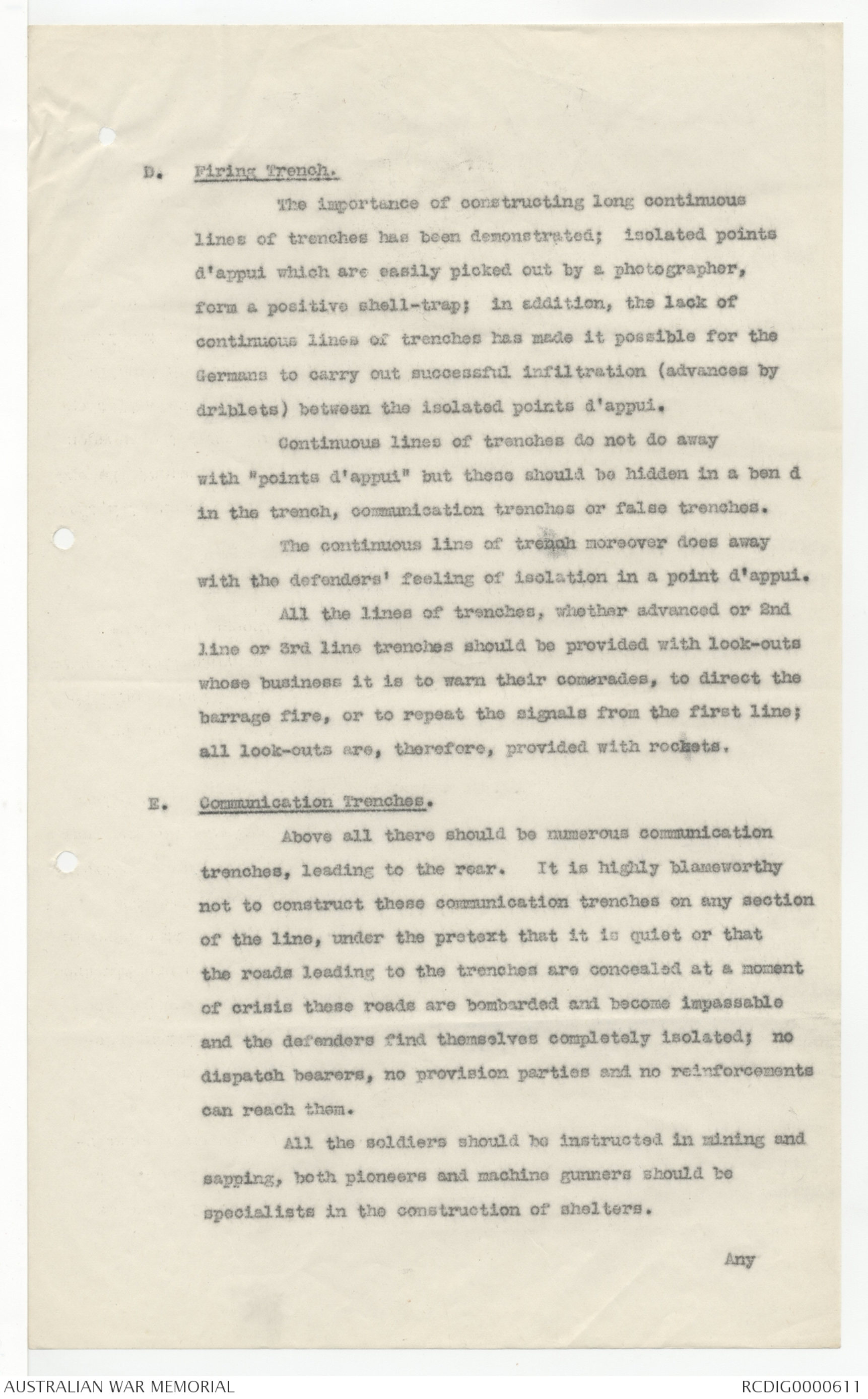

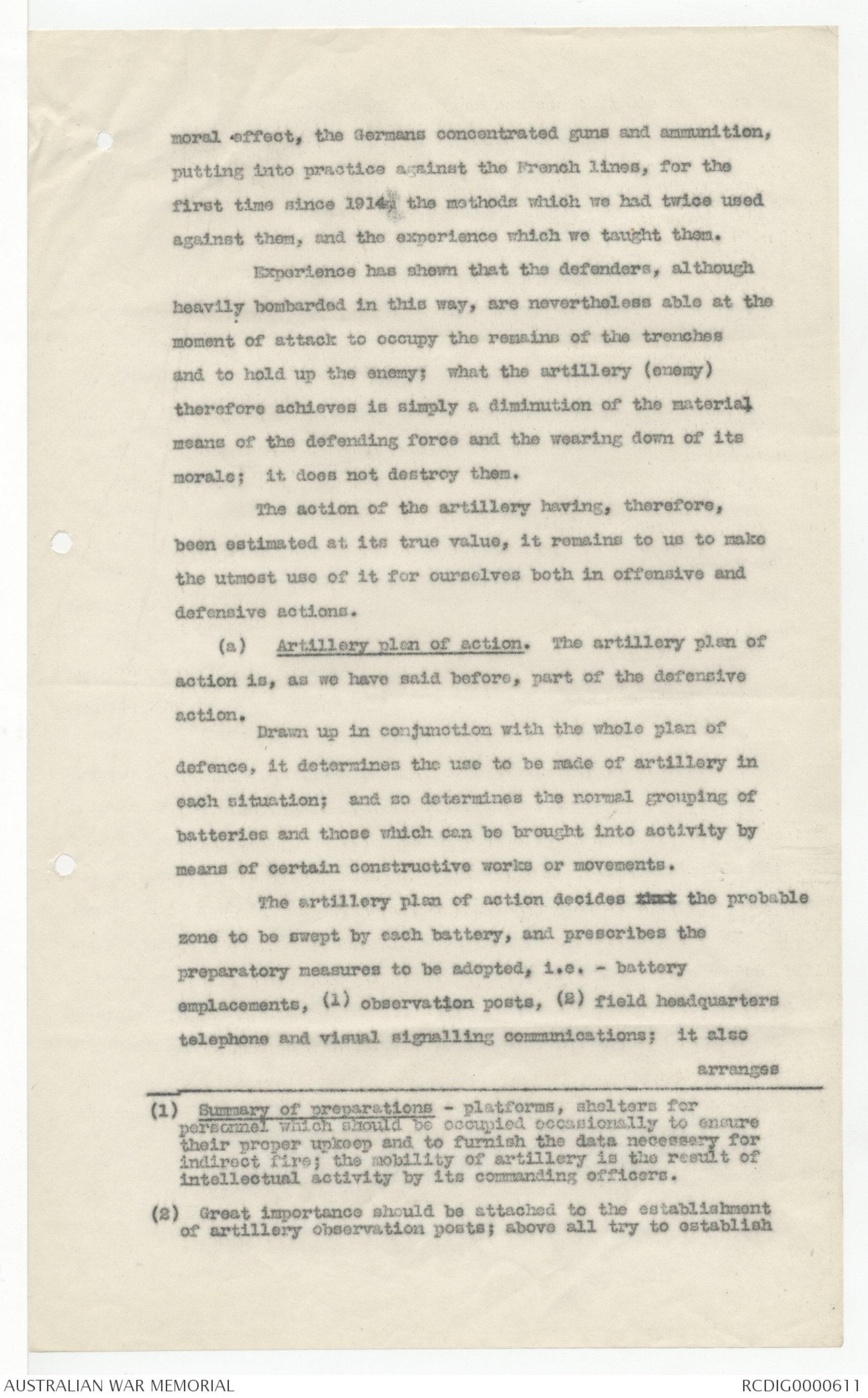

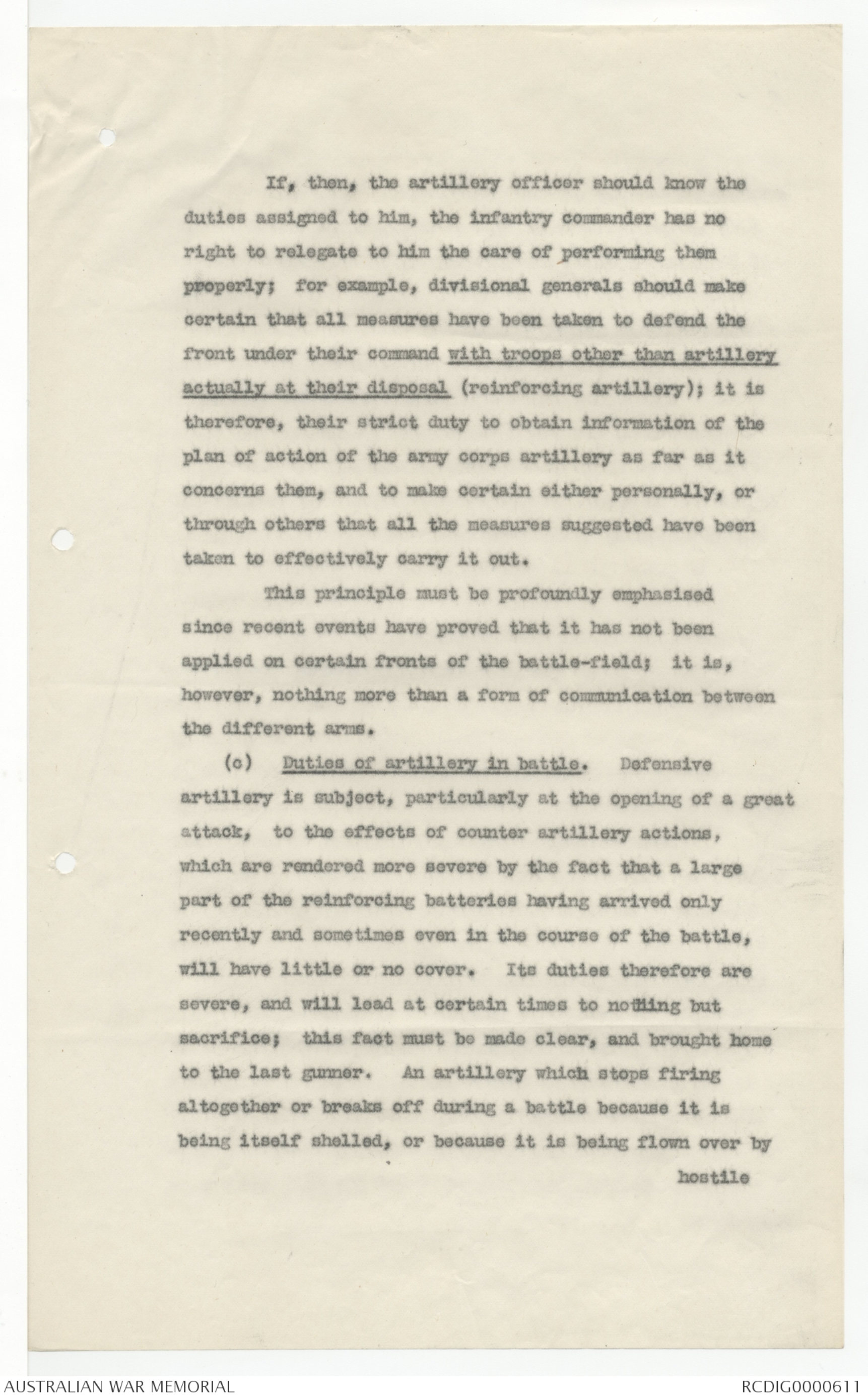
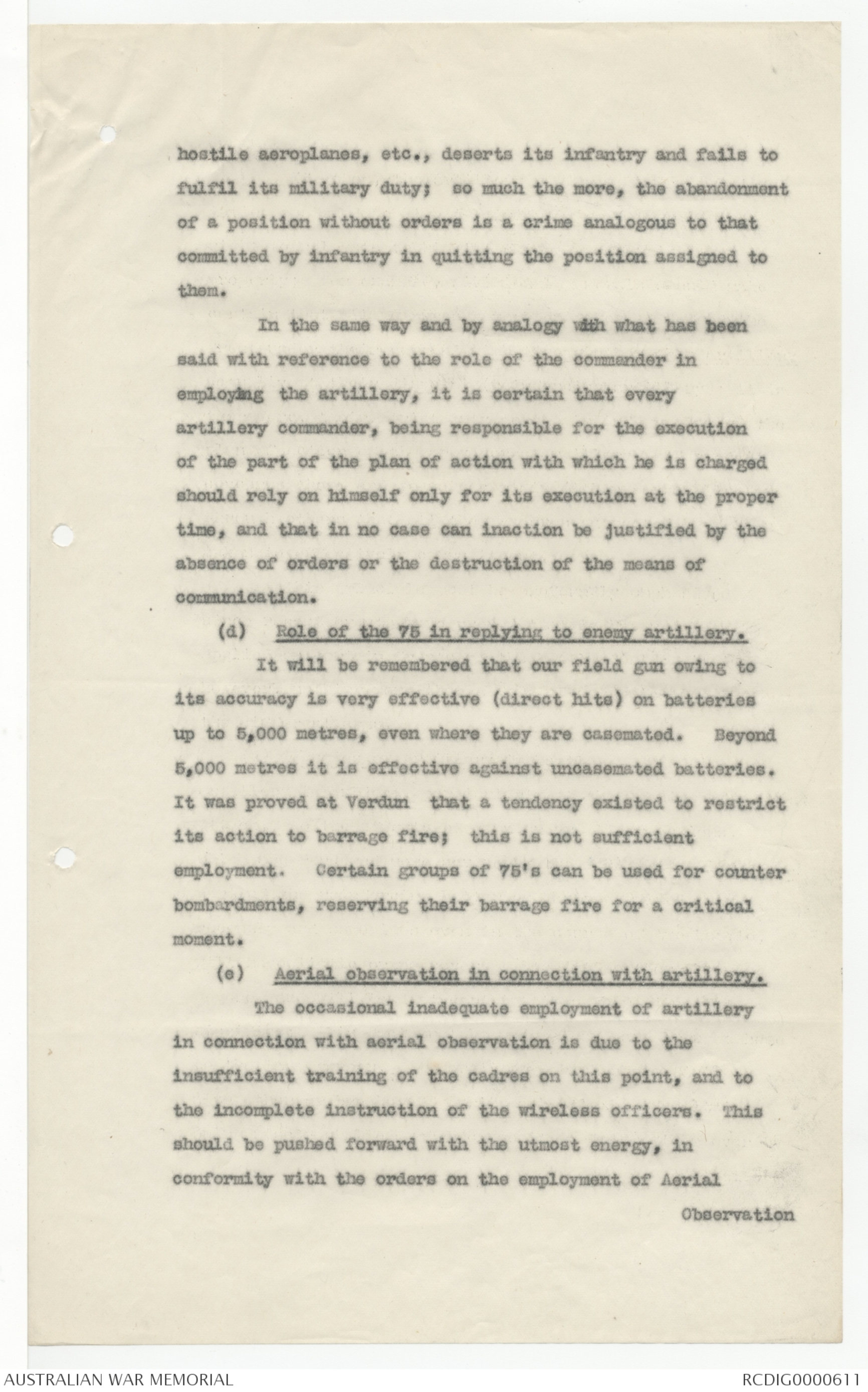
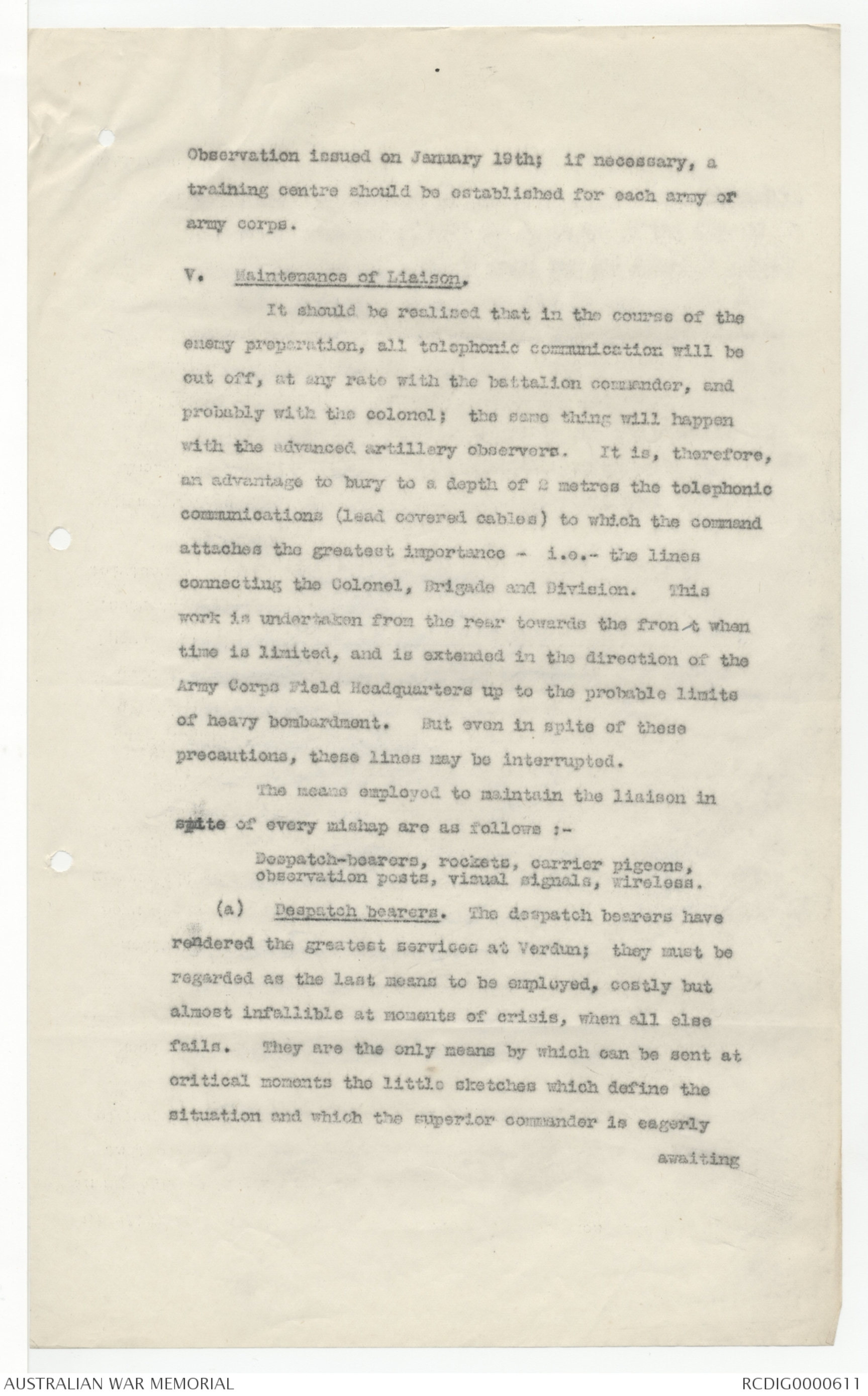
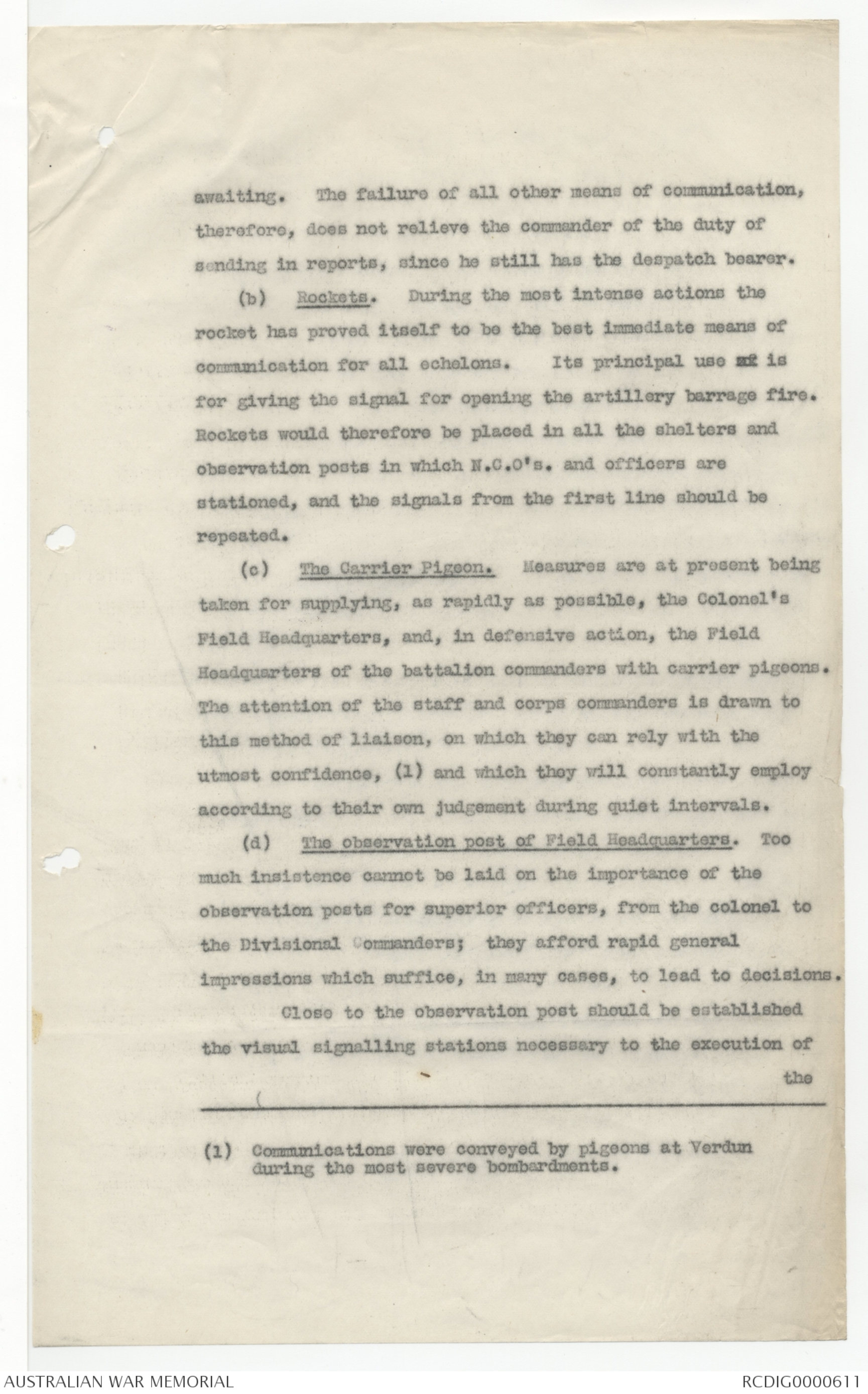
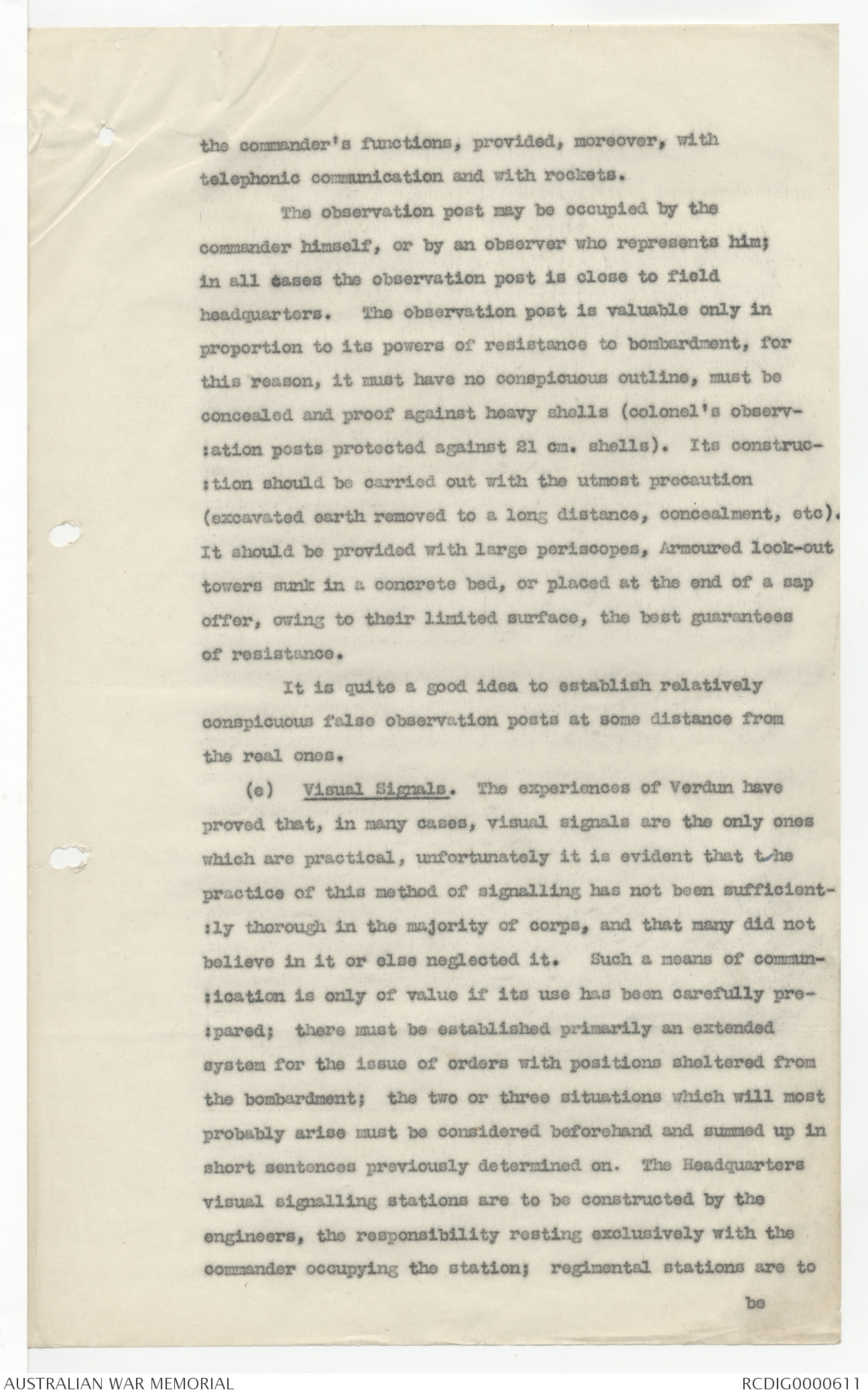
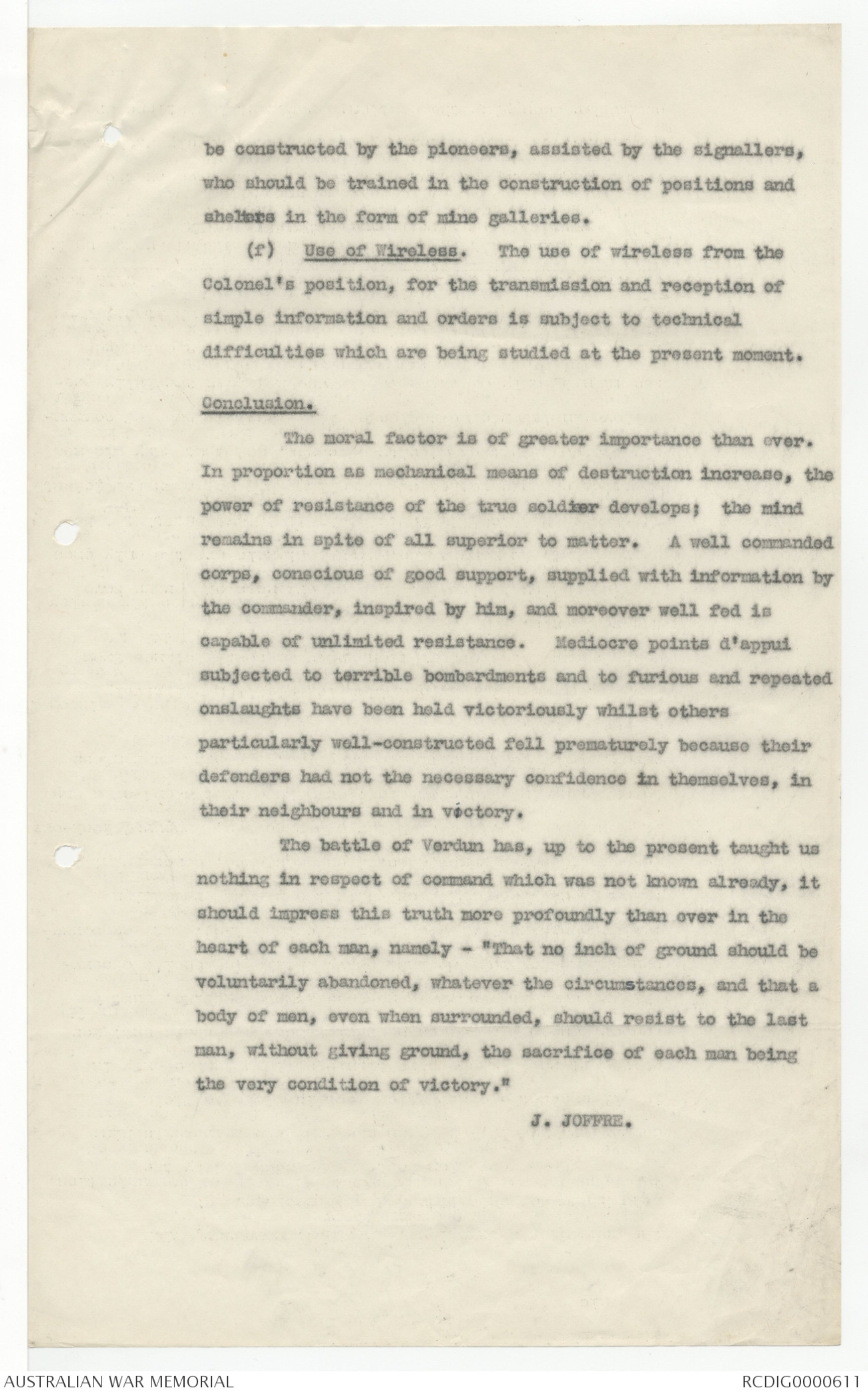
D .Firing Trench.
The importance of constructing long continuous
lines of trenches has been demonstrated; isolated points
d'appui which are easily picked out by a photographer,
form a positive shell-trap; in addition, the lack of
continuous lines of trenches has made it possible for the
Germans to carry out successful infiltration (advances by
driblets) between the isolated points d'appui.
Continuous lines of trenches do not do away
with "points d'appui" but these should be hidden in a bend
in the trench, communication trenches or false trenches.
The continuous line of trench moreover does away
with the defenders' feeling of isolation in a point d'appui.
All the lines of trenches, whether advanced or 2nd
line or 3rd line trenches should be provided with look-outs
whose business it is to warn their comerades, to direct the
barrage fire, or to repeat the signals from the first line;
all look-outs are, therefore, provided with rockets.
E. Communication Trenches.
Above all there should be numerous communication
trenches, leading to the rear. It is highly blameworthy
not to construct these communication trenches on any section
of the line, under the pretext that it is quiet or that
the roads leading to the trenches are concealed at a moment
of crisis these roads are bombarded and become impassable
and the defenders find themselves completely isolated; no
dispatch bearers, no provision parties and no reinforcements
can reach them.
All the soldiers should be instructed in mining and
sapping, both pioneers and machine gunners should be
specialists in the construction of shelters.
Any
Any Colonel who does not see that his regiment
is properly instructed on this point is to blame; the
renders his regiment liable to the gravest mistakes. Any
general officer who under any pretext whatsoever tolerates
inefficient or slack work in a regiment thereby fails in his
first duty.
IV. The Artillery and Artillery Methods.
The following methods were employed by the German
artillery at Verdun :-
Guns of every calibre turned on to the infantry
trenches, including the first line trenches.
Searching fire directed not only against all the
works of the front positions (including front line, supports,
shelters, observation posts, field headquarters, approaches);
but also against the second position.
Fire in zones with short bracket rather than exact
ranged fire.
Before an attack, a great concentration of fire
on the front defences to be attacked by the Infantry, and
barrage fire to the rear of them.
During the attack a continuation of barrage fire.
The German artillery was able, thanks to its great
number of batteries, at the same time both to develop its
preparatory fire in the infantry positions, and to maintain
as well an artillery duel such as bombarding our batteries
and concentrated fire of high explosive and lachrymose shells.
The use made of artillery by the Germans does not
introduce any new element into the most recent artillery
instructions. The moral effect produced in the beginning
was due to the concentration of enemy artillery over a some¬
what narrow front, and to the efficiency and long range of
the German heavy quick-firing guns. In order to produce this
moral
moral effect, the Germans concentrated guns and ammunition,
putting into practice against the French lines, for the
first time since 1914 the methods which we had twice used
against them, and the experience which we taught them.
Experience has shewn that the defenders, although
heavily bombarded in this way, are nevertheless able at the
moment of attack to occupy the remains of the trenches
and to hold up the enemy; what the artillery (enemy)
therefore achieves is simply a diminution of the material
means of the defending force and the wearing down of its
morale; it does not destroy them.
The section of the artillery having, therefore,
been estimated at its true value, it remains to us to make
the utmost use of it for ourselves both in offensive and
defensive actions.
(a) Artillery plan of action. The artillery plan of
action is, as we have said before, part of the defensive
action.
Drawn up in conjunction with the whole plan of
defence, it determines the use to be made of artillery in
each situation; and so determines the normal grouping of
batteries and those which can be brought into activity by
means of certain constructive works or movements.
The artillery plan of action decides xxx the probable
zone to be swept by each battery, and prescribes the
preparatory measures to be adopted, i.e. - battery
emplacements, (1) observation posts, (2) field headquarters
telephone and visual signalling communications; it also
arranges
(1) Summary of preparations -platforms, shelters for
personnel which should be occupied occasionally to ensure
their proper upkeep and to furnish the data necessary for
indirect fire; the mobility of artillery is the result of
intellectual activity by its commanding officers.
(2) Great importance should be attached to the establishment
of artillery observation posts; above all try to establish
arranges the preliminary registering date for indirect fire,
the replenishing of supplies, etc....
It deals with artillery reinforcements and makes
the necessary practical preparations similar to those
described above.
Every artillery plan of action should try to
attain both offensively and defensively an overwhelming
majority of concentrated fire. Various methods of
obtaining this concentration have been established; it
should be possible to execute one of these at the first
alarm.
The transmission and rapid execution of orders is
assured by decentralization (i.e.- the formation of groups
of batteries).
All artillery plans of action are communicated
to the General Staff and to the artillery officer
immediately inferior in rank.
(b) Duties of the Commanders of the various echelons
during the Artillery struggle.
The Commander determines the duties of the
artillery officer; the artillery officer carries out the
plan of action. Each has equal responsibility in whatever
echelon he may be placed. Success depends largely on
the communication maintained between them. The General
Staff and the artillery staff (army and army corps) should
neglect no mean s by which this connection can be rendered
still closer. (1)
If.
__________________________________________________________
observation posts with a good view of the whole country and
adequately connected with the batteries (visual signals
rockets, underground telephonic communication); the plan
of action cannot be carried out unless the commanders of
batteries can see and pass on their orders.
(1) See for example Note 17, 325 of 26th March on the subject
of the working of the S.R.A.
If, then, the artillery officer should know the
duties assigned to him, the infantry commander has no
right to relegate to him the care of performing them
properly; for example, divisional generals should make
certain that all measures have been taken to defend the
front under their command with troops other than artillery
actually at their disposal (reinforcing artillery); it is
therefore, their strict duty to obtain information of the
plan of section of the army corps artillery as far as it
concerns them, and to make certain either personally, or
through others that all the measures suggested have been
taken to effectively carry it out.
This principle must be profoundly emphasised
since recent events have proved that it has not been
applied on certain fronts of the battle-field; it is,
however, nothing more than a form of communication between
the different arms.
(c) Duties of artillery in battle. Defensive
artillery is subject, particularly at the opening of a great
attack, to the effects of counter artillery actions,
which are rendered more severe by the fact that a large
part of the reinforcing batteries having arrived only
recently and sometimes even in the course of the battle,
will have little or no cover. Its duties therefore are
severe, and will lead at certain times to nothing but
sacrifice; this fact must be made clear, and brought home
to the last gunner. An artillery which stops firing
altogether or breaks off during a battle because it is
being itself shelled, or because it is being flown over by
hostile
hostile aeroplanes, etc., deserts its infantry and fails to
fulfil its military duty; so much the more, the abandonment
of a position without orders is a crime analogous to that
committed by infantry in quitting the position assigned to
them.
In the same way and by analogy with what has been
said with reference to the role of the commander in
employing the artillery, it is certain that every
artillery commander, being responsible for the execution
of the part of the plan of action with which he is charged
should rely on himself only for its execution at the proper
time, and that in no case can inaction be justified by the
absence of orders or the destruction of the means of
communication.
(d) Role of the 75 in replying to enemy artillery.
It will be remembered that our field gun owing to
its accuracy is very effective (direct hits) on batteries
up to 5,000 metres, even where they are casemated. Beyond
5,000 metres it is effective against uncasemated batteries.
It was proved at Verdun that a tendency existed to restrict
its action to barrage fire; this is not sufficient
employment. Certain groups of 75's can be used for counter
bombardments, reserving their barrage fire for a critical
moment.
(e) Aerial observation in connection with artillery.
The occasional inadequate employment of artillery
in connection with serial observation is due to the
insufficient training of the cadres on this point, and to
the incomplete instruction of the wireless officers. This
should be pushed forward with the utmost energy, in
conformity which the orders on the employment of Aerial
Observation
Observation issued on January 19th; if necessary, a
training centre should be established for each army or
army corps.
V. Maintenance of Liaison.
It should be realised that in the course of the
enemy preparation, all telephonic communication will be
cut off, at any rate with the battalion commander, and
probably with the colonel; the same thing will happen
with the advanced artillery observers. It is, therefore,
an advantage to bury to a depth of 2 metres the telephonic
communications (lead covered cables) to which the command
attaches the greatest importance - i.e.- the lines
connecting the Colonel, Brigade and Division. This
work is undertaken from the rear towards the front when
time is limited, and is extended in the direction of the
Army Corps Field Headquarters up to the probable limits
of heavy bombardment. But even in spite of these
precautions, these lines may be interrupted.
The means employed to maintain the liaison in
spite of every mishap are as follows :-
Despatch-bearers, rockets, carrier pigeons,
observation posts, visual signals, wireless.
(a) Despatch bearers. The despatch bearers have
rendered the greatest services at Verdun; they must be
regarded as the last means to be employed, costly but
almost infallible at moments of crisis, when all else
fails. They are the only means by which can be sent at
critical moments the little sketches which define the
situation and which the superior commander is eagerly
awaiting
awaiting. The failure of all other means of communication,
therefore, does not relieve the commander of the duty of
sending in reports, since he still has the despatch bearer.
(b) Rockets. During the most intense actions the
rocket has proved itself to be the best immediate means of
communication for all echelons. Its principal use xx is
for giving the signal for opening the artillery barrage fire.
Rockets would therefore be placed in all the shelters and
observation posts in which N.C.O's. and officers are
stationed, and the signals from the first line should be
repeated.
(c) The Carrier Pigeon. Measures are at present being
taken for supplying, as rapidly as possible, the Colonel's
Field Headquarters, and, in defensive action, the Field
Headquarters of the battalion commanders with carrier pigeons.
The attention of the staff and corps commanders is drawn to
this method of liaison, on which they can rely with the
utmost confidence, (1) and which they will constantly employ
according to their own judgement during quiet intervals.
(d) The observation post of Field Headquarters. Too
much insistence cannot be laid on the importance of the
observation posts for superior officers, from the colonel to
the Divisional Commanders; they afford rapid general
impressions which suffice, in many cases, to lead to decisions.
Close to the observation post should be established
the visual signalling stations necessary to the execution of
the
_______________________________________________________
(1) Communications were conveyed by pigeons at Verdun
during the most severe bombardments.
the commander's functions, provided, moreover, with
telephonic communication and with rockets.
The observation post may be occupied by the
commander himself, or by an observer who represents him;
in all cases the observation post is close to field
headquarters. The observation post is valuable only in
proportion to its powers of resistance to bombardment, for
this reason, it must have no conspicuous outline, must be
concealed and proof against heavy shells (colonel's observation
posts protected against 21 cm. shells). Its construction
should be carried out with the utmost precaution
(excavated earth removed to a long distance, concealment, etc).
It should be provided with large periscopes, Armoured lock-out
towers sunk in a concrete bed, or placed at the end of a sap
offer, owing to their limited surface, the best guarantees
of resistance.
It is quite a good idea to establish relatively
conspicuous false observation posts at some distance from
the real ones.
(e) Visual Signals. The experiences of Verdun have
proved that, in many cases, visual signals are the only ones
which are practical, unfortunately it is evident that the
practice of this method of signalling has not been sufficiently
thorough in the majority of corps, and that many did not
believe in it or else neglected it. Such a means of communication
is only of value if its use has been carefully prepared;
there must be established primarily an extended
system for the issue of orders with positions sheltered from
the bombardment; the two or three situations which will most
probably arise must be considered beforehand and summed up in
short sentences previously determined on. The Headquarters
visual signalling stations are to be constructed by the
engineers, the responsibility resting exclusively with the
commander occupying the station; regimental stations are to
be
be constructed by the pioneers, assisted by the signallers,
who should be trained in the construction of positions and
shelters in the form of mine galleries.
(f) Use of Wireless. The use of wireless from the
Colonel's position, for the transmission and reception of
simple information and orders is subject to technical
difficulties which are being studied at the present moment.
Conclusion.
The moral factor is of greater importance than ever.
In proportion as mechanical means of destruction increase, the
power of resistance of the true soldier develops; the mind
remains in spite of all superior to matter. A well commanded
corps, conscious of good support, supplied with information by
the commander, inspired by him, and moreover well fed is
capable of unlimited resistance. Mediocre points d'appui
subjected to terrible bombardments and to furious and repeated
onslaughts have been held victoriously whilst others
particularly well-constructed fell prematurely because their
defenders had not the necessary confidence in themselves, in
their neighbours and in victory.
The battle of Verdun has, up to the present taught us
nothing in respect of command which was not known already, it
should impress this truth more profoundly than ever in the
heart of each man, namely -"That no inch of ground should be
voluntarily abandoned, whatever the circumstances, and that s
body of men, even when surrounded, should resist to the last
man, without giving ground, the sacrifice of each man being
the very condition of victory."
J. JOFFRE.
 Maralyn K
Maralyn KThis transcription item is now locked to you for editing. To release the lock either Save your changes or Cancel.
This lock will be automatically released after 60 minutes of inactivity.